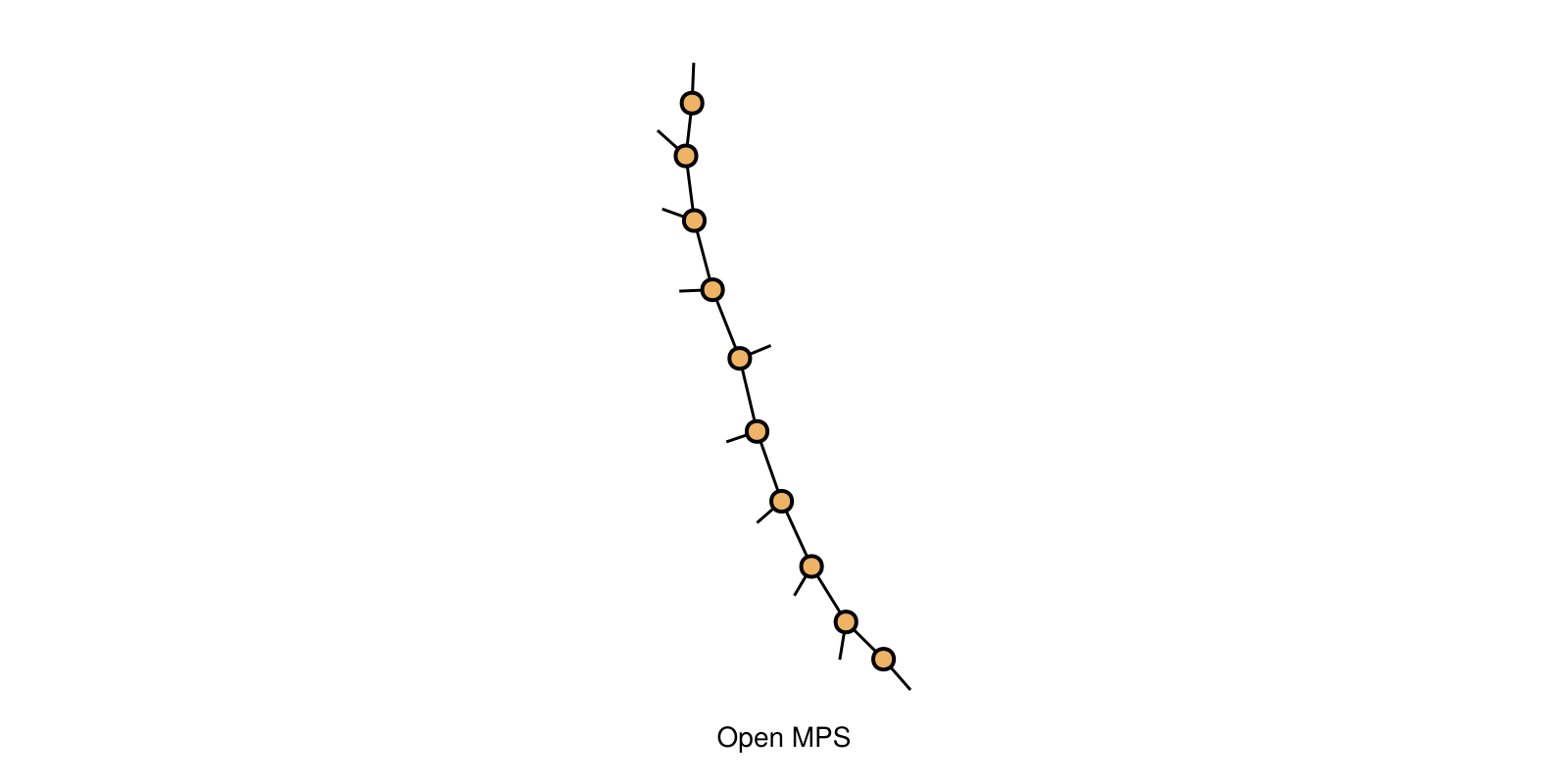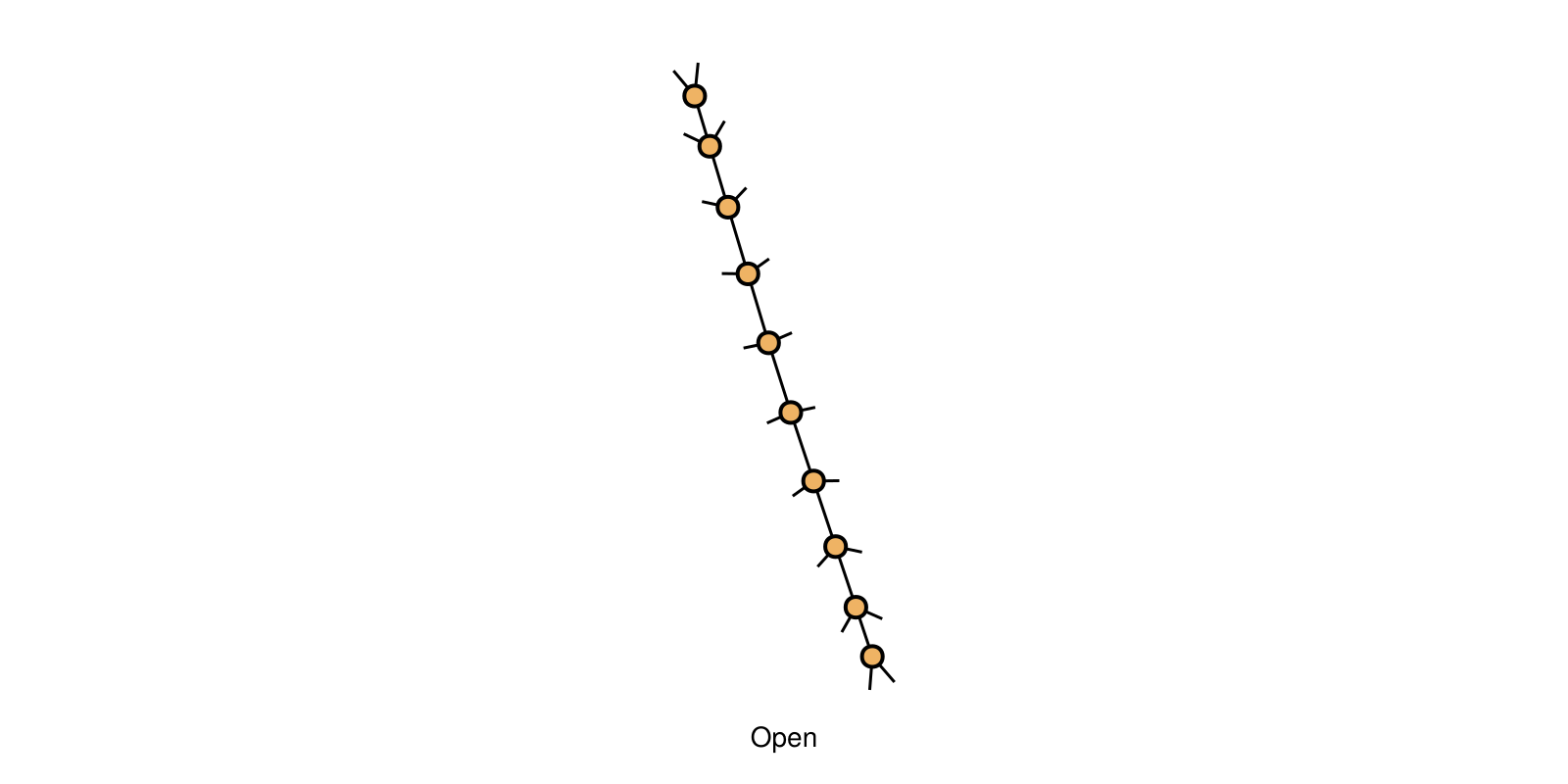Matrix Product States (MPS)
Matrix Product States (MPS) (also known as Tensor Trains) are Ansatz Tensor Networks whose tensors are laid out in a 1D chain. Depending on the boundary conditions, these chains can be open or closed (i.e. periodic boundary conditions).
Warning
Currently only Open boundary conditions are supported in Tenet.

In Tenet, a Matrix Product State can be easily created by passing a list of arrays to the MPS constructor:
julia> ψ = MPS([rand(2, 2), rand(2, 2, 4), rand(2, 4, 2), rand(2, 2)])
MPS (inputs=0, outputs=4)The default ordering of the indices on the MPS constructor is (physical, left, right), but you can specify the ordering by passing the order keyword argument:
julia> ϕ = MPS([rand(2, 2), rand(2, 2, 4), rand(4, 2, 2), rand(2, 2)]; order=[:l, :o, :r])
MPS (inputs=0, outputs=4)where :l, :r, and :o represent the left, right, and outer physical indices, respectively.
Additionally, Tenet has the rand function to generate random MPS with a given number of sites and maximum bond dimension:
julia> Φ = rand(MPS, n=8, maxdim=10)
MPS (inputs=0, outputs=8)Canonical Forms
An MPS representation is not unique: a single MPS can be represented in different canonical forms. The choice of canonical form can affect the efficiency and stability of algorithms used to manipulate the MPS. The current form of the MPS is stored as the trait Form and can be accessed via the form function:
julia> form(ψ)
NonCanonical()Warning
Depending on the form, Tenet will dispatch under the hood the appropriate algorithm which assumes full use of the canonical form, so be careful when making modifications that might alter the canonical form without changing the trait.
Tenet has the internal function Tenet.check_form to check if the MPS is in the correct canonical form. This function can be used to ensure that the MPS is in the correct form before performing any operation that requires it. Currently, Tenet supports the NonCanonical, CanonicalForm and MixedCanonical forms.
NonCanonical Form
In the NonCanonical form, the tensors in the MPS do not satisfy any particular orthogonality conditions. This is the default form when an MPS is initialized without specifying a canonical form. It is useful for general purposes but may not be optimal for certain computations that benefit from orthogonality.
Canonical Form
Also known as Vidal's form, the Canonical form represents the MPS using a sequence of tensors MPS is expressed as:
You can convert an MPS to the Canonical form by calling canonize!:
julia> canonize!(ψ)
MPS (inputs=0, outputs=4)
julia> form(ψ)
Canonical()MixedCanonical Form
In the MixedCanonical form, the Schmidt coefficients are contained in one tensor, called the orthogonality center, and the rest of the tensors locating to the left and right side are left- and right-canonical; i.e. isometries pointing to the right and left directions respectively.
Tip
If the Schmidt coefficients are spread out along multiple tensors but localized, then MixedCanonical accepts using a Vector{<:Site} for representing the orthogonality center.
You can convert an MPS to the MixedCanonical form and specify the orthogonality center using mixed_canonize!. Additionally, one can check that the MPS is effectively in mixed canonical form using the function isisometry, which returns true if the Tensor at that particular site is an isometry pointing at direction dir:
julia> mixed_canonize!(ψ, Site(2))
ERROR: ArgumentError: `orthog_center` must be a `Site` or a `Vector{Site}`
julia> isisometry(ψ, 1; dir=:right) # Check if the first tensor is left canonical
ERROR: KeyError: key 1 not found
julia> isisometry(ψ, 3; dir=:left) # Check if the third tensor is right canonical
ERROR: KeyError: key 3 not found
julia> form(ψ)
Canonical()Matrix Product Operators (MPO)
Matrix Product Operators (MPO) are the operator version of Matrix Product States (MPS). The major difference between them is that MPOs have 2 indices per site (1 input and 1 output) while MPSs only have 1 index per site (i.e. an output).
open_mpo = rand(MPO, n=10, maxdim=4)
To apply an MPO to an MPS, you can use the evolve! function:
julia> mps = rand(MPS; n=10)
MPS (inputs=0, outputs=10)
julia> evolve!(mps, open_mpo; normalize=false)
MPS (inputs=0, outputs=10)Additional Resources
For more in-depth information on Matrix Product States and their canonical forms, you may refer to:
- Schollwöck, U. (2011). The density-matrix renormalization group in the age of matrix product states. Annals of physics, 326(1), 96-192.
DocumenterMermaid.MermaidScriptBlock([...])